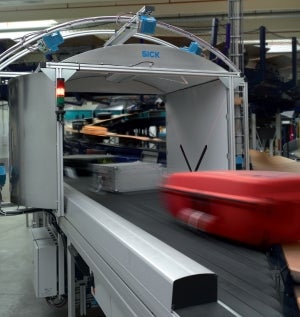
SICK’s activities focus on providing clients with factory facilities, logistics and process automation, with intelligent sensors and sensor solutions. In terms of luggage transportation, SICK offers suitable solutions for the entire process chain, starting with check-in and bag drop through to the whole airport baggage handling infrastructure to the loading of the aircraft.
Today, we see a major trend and strong interest in new self services, like self check-in and self bag drop; similarly the passengers also demand information about the whole journey of their luggage, from check-in to the common destination. The traveller expects state-of-the-art technology that offers intuitive and convenient processes.
To fulfil these customers’ baggage handling desires and improvements, quality processes are required. An increasing number of airports and airlines respectively already have self bag drop machines in operation to improve the passenger experience by giving them the option to deposit their luggage by themselves at the bag drop system without any assistance given by an airline agent. The new automatic systems simplify the drop off process and lead to shortened waiting queues as the transaction time per passenger is significantly reduced.
Today, SICK covers any kind of sensor tasks for self bag drop systems. From reading the passenger’s boarding card, automatic identification of the bag tag (barcode and / or RFID), detecting oversized luggage, anti-intrusion solutions to avoid forbidden access, all the way through to safety control according to regional safety regulations. Self Bag Drop systems with SICK equipment are installed in real environments at airports and in long-term trials all around the world, from Australia to Japan, Europe, the US, Canada and the Middle East.
After the check-in process, the luggage, identified with bag tags, is securely transported to the target destination within the airport building. Sensor technology from SICK reads the bag tag information, and determines the size, position or shape of luggage items, which helps to protect handling system parts from damage and optimises processes for the intermediate storage or automatic loading of bags.
Airlines that intend to provide passengers with information about the current localisation of their luggage, from journey to destination, can rely on the relevant data coming from SICK’s automatic luggage identification systems (ALIS) installed in the baggage handling systems, from check-in to make-up for outbound luggage, and baggage reclaim for inbound luggage. SICK is capable of offering reading gates based on barcodes, RFID and hybrid technology (barcode and RFID); both technologies from a single source. High read rates lead to significant improvements in the performance of an airport’s entire sorting and transport system, a reduction in manual corrective work, fewer complaints, and thus increased satisfaction among all parties: the airports, airlines and passengers.
On the bag’s journey right before the bag will be loaded into a luggage cart or an ULD, SICK’s systems measure the position, dimensions and contour of airport luggage to enable the automation of the make-up process by means of automatic luggage robots. Another SICK sensor (installed in the robot) scans the real loading status in the cart/ULD at every loading operation, and provides the robot’s control system with data for the space optimised loading plan.
Besides the above mentioned applications in the luggage logistics chain, SICK is also a competent partner for cargo and catering facility sensor solutions, for passenger boarding bridges, aircraft docking systems and airport ground vehicles; in addition, SICK supplies appropriate solutions to the airport’s building infrastructure and security processes, which means the chances to run into SICK sensor solutions somewhere in the aviation industry is extremely high.
For more information, please contact SICK.

